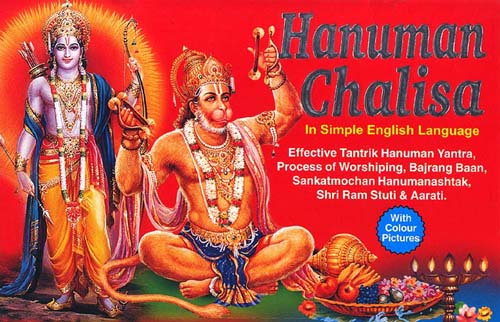The Hanuman Chalisa: A Hymn of Devotion, Strength, and Humility

The Hanuman Chalisa, a devotional hymn dedicated to Lord Hanuman, is a powerful and widely recited prayer among Hindus. Composed by the 16th-century poet Goswami Tulsidas, it beautifully encapsulates the virtues and glories of Lord Hanuman, a revered deity symbolizing strength, devotion, and perseverance. More than just a prayer, the Hanuman Chalisa is a source of inspiration, guidance, and solace for millions, offering a pathway to connect with Lord Hanuman and imbibe his exemplary qualities. This article delves deep into the Hanuman Chalisa, exploring its origins, its meaning, its significance, its recitation practices, and its enduring impact on Hindu culture and spirituality.
The Origins of the Hanuman Chalisa: A Poet’s Devotion
The Hanuman Chalisa is attributed to Goswami Tulsidas, a prominent figure in Hindu literature and philosophy. Tulsidas, a devout follower of Lord Rama, is believed to have composed the Hanuman Chalisa in Awadhi, a vernacular language of North India, making it accessible to a wider audience. The composition is a beautiful expression of Tulsidas’s profound devotion to Lord Hanuman, whom he considered the embodiment of ideal devotion and strength.
The legend surrounding the creation of the Hanuman Chalisa is deeply intertwined with Tulsidas’s own spiritual journey. It is said that Tulsidas had a profound experience with Lord Hanuman, which inspired him to compose this hymn. The Hanuman Chalisa is not just a collection of verses; it is a heartfelt conversation between the devotee and Lord Hanuman, filled with reverence, praise, and supplication.
Understanding the Lyrics: A Tapestry of Praise and Virtues
The Hanuman Chalisa is a 40-verse hymn (excluding the introductory and concluding verses), each verse laden with meaning and symbolism. The verses describe Hanuman’s physical prowess, his unwavering devotion to Lord Rama, his selfless service, and his various divine qualities. The hymn also narrates key episodes from Hanuman’s life, highlighting his strength, courage, and wisdom.
The language of the Hanuman Chalisa is poetic and evocative, filled with metaphors and similes that paint a vivid picture of Lord Hanuman’s greatness. Each verse is carefully crafted to convey a specific aspect of Hanuman’s character and his relationship with Lord Rama. Understanding the meaning of each verse is crucial to fully appreciating the depth and power of the Hanuman Chalisa. Many translations and commentaries are available, helping devotees to unlock the rich symbolism and spiritual insights embedded within the hymn.
The Significance of the Hanuman Chalisa: A Path to Divine Grace
The Hanuman Chalisa holds immense significance in Hindu tradition. It is believed that reciting the Hanuman Chalisa with sincerity and devotion can invoke Lord Hanuman’s blessings. Devotees believe that regular recitation can bring strength, courage, wisdom, and protection. It is also believed to ward off negative energies and instill a sense of peace and tranquility.
The Hanuman Chalisa is often recited daily, particularly on Tuesdays, which is considered auspicious for Lord Hanuman. It is also a common practice to recite the Chalisa during festivals and special occasions dedicated to Lord Hanuman. Many Hindus consider the Hanuman Chalisa an essential part of their daily prayers, reciting it as a way to connect with Lord Hanuman and seek his divine grace.
Recitation Practices: Connecting with the Divine
The recitation of the Hanuman Chalisa is more than just a ritual; it is a deeply personal and spiritual experience. Devotees often recite the Chalisa with great reverence, focusing their minds on Lord Hanuman and his virtues. Some prefer to recite it aloud, while others prefer silent recitation. The key is to recite with sincerity and devotion, allowing the words to penetrate the heart and mind.
Many devotees have a dedicated space or altar where they keep an image or idol of Lord Hanuman. They may offer flowers, incense, and lamps while reciting the Chalisa. Some also observe a fast on Tuesdays as a mark of respect for Lord Hanuman. The recitation of the Hanuman Chalisa is a deeply personal practice, and each individual may have their own way of connecting with the divine through this powerful hymn.

The Enduring Impact: A Timeless Hymn
The Hanuman Chalisa has transcended generations and continues to be a widely recited hymn among Hindus worldwide. Its timeless message of devotion, strength, and humility resonates with people of all ages and backgrounds. The simplicity of its language and the accessibility of its message have contributed to its enduring popularity.
The Hanuman Chalisa is not just a religious text; it is a cultural treasure. Numerous writers, musicians, and artists have been influenced by it. Its verses are often quoted in everyday conversations, and its message of devotion and perseverance is woven into the fabric of Hindu culture. The Hanuman Chalisa is more than just a hymn; it is a source of inspiration, guidance, and solace for millions, a testament to the enduring power of faith and devotion.
Beyond Ritual: Imbibing Hanuman’s Qualities
The recitation of the Hanuman Chalisa is not merely a ritualistic practice; it is a call to imbibe the virtues embodied by Lord Hanuman. Hanuman is revered as the epitome of devotion, strength, courage, wisdom, and humility. By reciting the Hanuman Chalisa, devotees aspire to cultivate these qualities in their own lives.
The hymn serves as a constant reminder of Hanuman’s selfless service to Lord Rama and his unwavering devotion. It encourages devotees to emulate Hanuman’s example and strive for a life of purpose, dedication, and humility. The Hanuman Chalisa is not just a prayer; it is a guide to living a virtuous and meaningful life.
The Hanuman Chalisa in Popular Culture: A Continuing Influence
The Hanuman Chalisa’s influence extends beyond religious practices and into popular culture. Its verses are often incorporated into music, films, and television shows. Many artists have created their own renditions of the Hanuman Chalisa, making it accessible to a wider audience. The hymn’s message of devotion and strength continues to inspire and resonate with people from all walks of life.
The Hanuman Chalisa’s presence in popular culture reflects its enduring relevance and its ability to connect with people on a deeper level. It is a testament to the power of faith, devotion, and the timeless wisdom embedded within this sacred hymn.
FAQs
What is the Hanuman Chalisa?
The Hanuman Chalisa is a devotional prayer consisting of 40 verses written in praise of Lord Hanuman. It is believed that chanting or reciting the Hanuman Chalisa invokes the blessings of Lord Hanuman, who is regarded as the symbol of strength, devotion, and loyalty. The Chalisa is written in Hindi by Tulsidas and is often recited by devotees to seek protection, courage, and the removal of obstacles.
What are the lyrics of the Hanuman Chalisa?
The lyrics of the Hanuman Chalisa are composed in a poetic form, primarily in the Awadhi dialect of Hindi. It praises Lord Hanuman’s qualities such as his unwavering devotion to Lord Rama, immense strength, and wisdom. The verses describe Hanuman’s birth, his feats, and his role as a devoted servant of Lord Rama. The poem also emphasizes Hanuman’s ability to remove fears, obstacles, and misfortunes for his devotees.
What is the meaning of the Hanuman Chalisa?
The Hanuman Chalisa is essentially a prayer for invoking Lord Hanuman’s divine grace and blessings. The verses describe various aspects of Hanuman’s character, such as his intelligence, his valor, his capacity for devotion, and his role as a protector. The meaning of the Chalisa is that by reciting it, devotees can receive protection from evil, overcome challenges, and strengthen their faith in Lord Rama.
How many verses are there in the Hanuman Chalisa?
The Hanuman Chalisa contains exactly 40 verses, which is why it is referred to as “Chalisa.” In addition to these 40 verses, the prayer also includes an introductory couplet, making it a total of 42 verses. The 40 verses are a mix of praises, appeals, and invocations to Lord Hanuman.
When should the Hanuman Chalisa be recited?
The Hanuman Chalisa can be recited at any time of the day or night, although many people choose to recite it on Tuesdays and Saturdays, which are considered auspicious days dedicated to Lord Hanuman. Devotees often recite it to seek protection, strength, and guidance during difficult times or to express their gratitude for Lord Hanuman’s blessings.
In summary
The Hanuman Chalisa stands as a beacon of faith and inspiration for millions of Hindus. Its beautiful verses, laden with meaning and symbolism, offer a pathway to connect with Lord Hanuman and imbibe his exemplary qualities. More than just a prayer, the Hanuman Chalisa is a source of strength, courage, wisdom, and solace. Its enduring popularity and its pervasive influence in Hindu culture are testaments to the power of devotion and the timeless wisdom contained within this sacred hymn. The Hanuman Chalisa continues to guide, inspire, and uplift, reminding devotees of the importance of faith, humility, and selfless service.
To read more, Click here



Leave a Comment